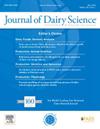Estimations of prepartum feed intake and its effects on transition metabolism and subsequent milk production
IF 3.7
1区 农林科学
Q1 AGRICULTURE, DAIRY & ANIMAL SCIENCE
引用次数: 0
Abstract
The objectives of this study were to identify factors associated with prepartum DMI, evaluate the performance of linear models to estimate prepartum DMI using different classes of predictors, and investigate the consequences of different levels of prepartum DMI on transition metabolism and lactation performance. Individual feed intake of nulliparous (n = 100) and parous cows (n = 173) was measured by automatic feeding bins from d −35 to 98 relative to calving. Rumination and physical activities were monitored by wearable sensors. Blood metabolites were measured on d −21, −10, −3, 0, 3, 7, 10, 14, and 21. Body weight and BCS were assessed throughout the study. The average prepartum DMI as percentage of BW (DMIpBW) was calculated for each cow and used as dependent variable of linear models. Parity, prepartum BCS and BW, 305-d milk production in the previous lactation, milk yield at dry-off (MYDO), and the length of the dry period were associated with DMIpBW. These factors explained 41% of the variation in DMIpBW across all cows and 49% in parous cows.. Estimations of DMIpBW were improved when data on prepartum rumination and blood metabolites were added into the predictive models. In the latter, the adjusted R2 increased to values between 47% and 61%, and selected models performed consistently in a 5-fold cross-validation analysis. To evaluate the implications of DMIpBW to transition metabolism and performance, cows were ranked within parity and classified into terciles as low (LFI), moderate (MFI), or high feed intake (HFI). The mean DMI was 1.44%, 1.70%, and 1.91% ± 0.01% of BW, respectively. No differences in BW were observed in nulliparous cows, but all 3 groups of parous cows differed (LFI = 892, MFI = 849, HFI = 798 ± 8 kg). The proportion of cows with BCS >3.5 at enrollment differed among all groups, and averaged 67.4%, 55.1%, and 36.5% ± 6%, respectively. For parous cows, 305-d milk production and MYDO differed among all groups and averaged 9,808, 10,457, and 11,182 ± 233 kg, and 18.1, 23.1, and 26.2 ± 1 kg/d, respectively. After calving, DMI (LFI = 20.9, MFI = 21.9, and HFI = 22.1 ± 0.2 kg/d) and milk yield (LFI = 36.7, MFI = 38.2, and HFI = 38.3 ± 0.4 kg/d) was lower in LFI cows compared with the other 2 groups. Postpartum energy balance differed among all groups and averaged −2.79, −1.63, and −0.66 ± 0.3 Mcal/d for LFI, MFI, and HFI, respectively. During the transition period, LFI cows had higher serum concentrations of nonesterified fatty acids, BHB, Cl (prepartum only), and aspartate aminotransferase (AST; postpartum only), and lower serum concentrations of cholesterol, P, glutamate dehydrogenase, gamma-glutamyl transferase (prepartum only), AST (prepartum only), urea (parous only), and superoxide dismutase activity (parous only). In conclusion, a low level of prepartum DMI was associated with fatter and heavier cows, lower milk production in previous lactation, important adjustments in energy metabolism during the transition period, and moderate losses in DMI and milk yield in the subsequent lactation. Moreover, the inclusion of prepartum rumination activity and target blood metabolites into predictive models improved the estimations of prepartum DMI.
产前饲料摄入量估算及其对过渡代谢和后续产奶量的影响。
本研究的目的是确定与产前DMI相关的因素,评估使用不同类别的预测因子估算产前DMI的线性模型的性能,并研究不同水平的产前DMI对过渡代谢和泌乳性能的影响。在产犊前的第 -35 天至第 98 天期间,通过自动饲喂箱测量空怀母牛(n = 100)和准空怀母牛(n = 173)的个体采食量。反刍和体力活动由可穿戴传感器监测。在第 -21、-10、-3、0、3、7、10、14 和 21 天测量血液代谢物。体重(BW)和体况评分(BCS)的评估贯穿整个研究过程。计算每头奶牛产前平均DMI占体重的百分比(DMIpBW),并将其作为线性模型的因变量。胎次、产前BCS和体重、上一泌乳期(M305)和干奶期(MYDO)的产奶量以及干奶期的长度与DMIpBW有关,并解释了所有奶牛41%的变异,以及奇数奶牛49%的变异。在预测模型中加入产前反刍和血液代谢物数据后,DMIpBW 的估计值有所提高。在后者中,调整后的 R-Sq 值增加到 47% 到 61%,所选模型在 5 倍交叉验证分析中表现一致。为了评估DMIpBW对过渡代谢和生产性能的影响,对奶牛进行了奇数排序,并将其分为低采食量(LFI)、中采食量(MFI)和高采食量(HFI)三个等级。平均 DMI 分别为体重的 1.44%、1.70% 和 1.91 ± 0.01%。无产仔数奶牛的体重没有差异,但所有 3 组准产仔数奶牛的体重均有差异(LFI = 892 千克、MFI = 849 千克、HFI = 798 ± 8 千克)。各组入学时 BCS > 3.5 的奶牛比例各不相同,平均比例分别为 67.4%、55.1% 和 36.5 ± 6%。对于准母牛,M305 和 MYDO 在各组之间存在差异,平均值分别为 9808、10457 和 11182 ± 233 kg,以及 18.1、23.1 和 26.2 ± 1 kg/d。产犊后,LFI奶牛的DMI(LFI = 20.9、MFI = 21.9和HFI = 22.1 ± 0.2 kg/d)和产奶量(LFI = 36.7、MFI = 38.2和HFI = 38.3 ± 0.4 kg/d)低于其他两组。产后EBAL在各组之间存在差异,LFI、MFI和HFI组的平均值分别为-2.79、-1.63和-0.66 ± 0.3 Mcal/d。在过渡期,LFI奶牛血清中的NEFA、BHB、Cl(仅产前)和AST(仅产后)浓度较高,而血清中的胆固醇、P、GLDH、GGT(仅产前)、AST(仅产前)、尿素(仅产后)和SOD活性(仅产后)浓度较低。总之,产前DMI水平低与奶牛体型较胖、体重较重、前一泌乳期产奶量较低、能量代谢发生重大调整以及后一泌乳期DMI和产奶量的适度损失有关。此外,将产前反刍活动和目标血液代谢物纳入预测模型可提高对产前DMI的估计。
本文章由计算机程序翻译,如有差异,请以英文原文为准。
求助全文
约1分钟内获得全文
求助全文
来源期刊

Journal of Dairy Science
农林科学-奶制品与动物科学
CiteScore
7.90
自引率
17.10%
发文量
784
审稿时长
4.2 months
期刊介绍:
The official journal of the American Dairy Science Association®, Journal of Dairy Science® (JDS) is the leading peer-reviewed general dairy research journal in the world. JDS readers represent education, industry, and government agencies in more than 70 countries with interests in biochemistry, breeding, economics, engineering, environment, food science, genetics, microbiology, nutrition, pathology, physiology, processing, public health, quality assurance, and sanitation.
 求助内容:
求助内容: 应助结果提醒方式:
应助结果提醒方式:


